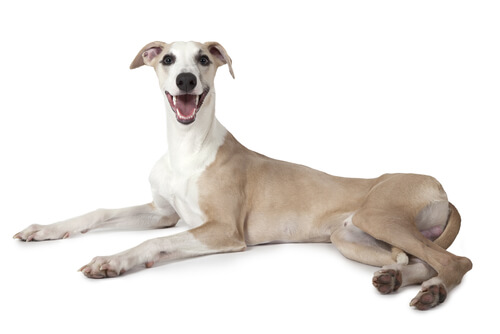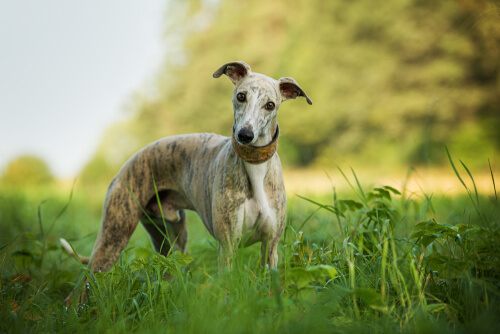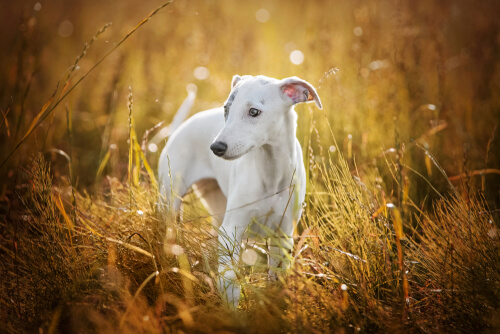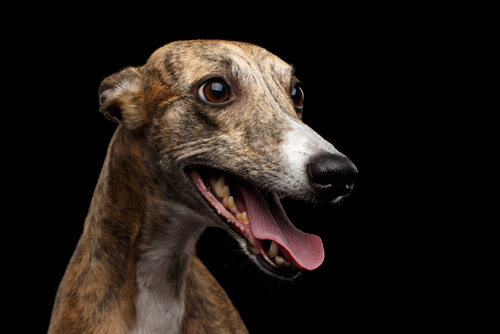
| Kingdom | Animalia |
| Phylum | Chordata |
| Class | Mammalia |
| Order | Carnivora |
| Family | Canidae |
| Genus | Canis |
| Species | C. lupus |
| Species | C. lupus familiaris |
| Niche | Domestic |
| Height | 17.5-22.5 in (44-57 cm) |
| Weight | 20-42 lbs (9-19 kg) |
| Lifespan | years |
| Social Structure | Social, domesticated |
| Breed Status | Common |
| Preferred Habitat | Domestic |
| Average Litter Size | 6 puppies |
| Main Food Item | Dog Food |
The Basics
The Whippet is a medium-sized breed of domestic dog. Descendant from greyhounds, they are slender and long, allowing them to find success in modern-day agility and other dog competitions. Historically referred to as ‘snap dogs’, they were also used for hunting rabbits. In fact, their name itself is derived from an Olde English word that meant ‘to move briskly’.
Whippets appear much like greyhounds but smaller, weighing about 10-42 lbs (9.1-19.1 kg) and standing about 17.5-22.5 in (44-57 cm). In judging whippets as show dogs, color is considered immaterial. Therefore, whippets can be found in a large array of color morphs such as fawn, brindle, cream, or some combinations of these. The fastest dog in their weight class, they have a streamlined shape, long muzzle, and small ears. Their coats are short and dense.

History
Originally, Whippets were bred to hunt game such as rabbits in an open area or field, chasing them down once they were spotted. They are closely related to greyhounds, which were bred in various size varieties over the centuries, eventually becoming distinguished as distinct breeds. Greyhounds have been represented in human history as far back as Ancient Egypt, and more recently in medieval England, where a similar breed to the modern-day Whippet was used as a ratting dog. The first written reference to the dog using the term Whippet is in 1610, and The Kennel Club and the American Kennel Club ultimately recognized the breed in 1891 and 1888, respectively.
In the mid-1800s, Whippets were bred more for racing than for hunting and were used to compete in sports like ‘hare coursing’, ultimately leading to racing forms similar to modern-day greyhound racing, in which dogs chase a false rabbit around a race track.
Whippets as Pets
Whippets are common pets due to their manageable size and gentle demeanor. They are also a quiet breed, not often barking. This may not make them highly suitable as guard dogs. Despite their reputation as being very fast, they typically like to spend much of their days relaxing, making them good house dogs. They are independent, but still highly trainable with the right amount of attention and consistency.
They are good with children and not particularly aggressive with other pets. However, due to their history of being bred to chase rabbits and other rodents, they tend to chase other small animals like smaller pets. Females give birth to litters of about 6 puppies and individual dogs typically live for about 12-14 years.

Fun Facts about Whippet!
Whippets are great pets and one of the fastest dog breeds there is. Whippet-like dogs were once kept by Kings in the Old World. Ultimately, they were bred to race and their popularity only increased on arrival in America.
Brought to Boston
The original Whippets in America were those that accompanied British mil operators, particularly in Massachusetts and New England. It was a success in the New World just as it had been in England, and now it is the 55th most popular breed in the country according to the American Kennel Club. They’re not just small greyhounds as is the common misconception but are more the result of crossing greyhounds with smaller breeds such as terriers and Italian Greyhounds during this time.
Poor Man’s Race Horse
Modern-day whippets are common as pets and in legitimate agility, lure coursing, dock diving, flyball, and other competitions. However, Whippets also have a history as being used as an amateur race dog by their keepers. This is no coincidence, given that they are probably the fastest accelerating dog breed and certainly the fastest in their weight class. Ultimately, they were bred for this purpose more than anything else.

Racing Whippets were not always purebred. It was considered more important to breed dogs that could win races. Therefore, they were often crossed with terriers and other species. However, apparently threatened by the success of the non-purebred dogs, a movement to make whippet racing exclusive to purebreds culminated in the formation of the Whippet Club Racing Association in 1968. The WCRA excluded dogs that weren’t purebred Whippets, further leading to the development of the modern-day breed.
But Fit for a King
In a painting presented to Louis XV by Jean-Baptiste Oudry, the son of a Parisian artist and art dealer who lived from 1686-1755, two Whippet-like dogs are featured that were likely kept by the king. Indeed, Louis XV installed many of Oudry’s portraits of his favorite dogs in his famous chateaus, including these two Whippets.
